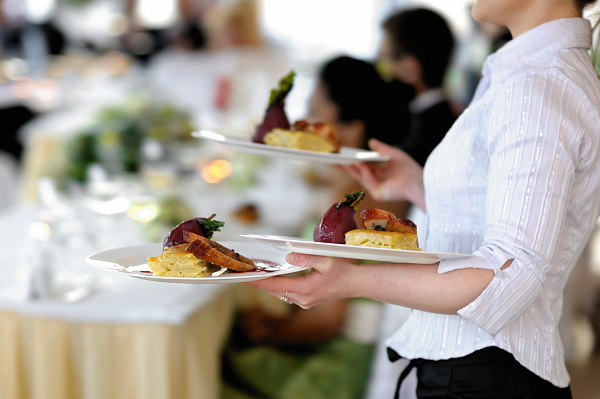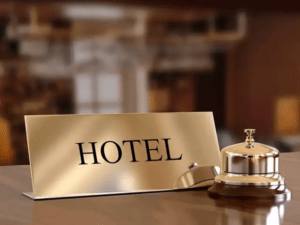Basic Food & Beverage Service- Hotel food and beverage service is an essential aspect of the hospitality industry, encompassing various functions related to providing meals, drinks, and related services to guests. Here’s a basic overview of food and beverage service in a hotel:
- Restaurant and Dining Areas: Hotels typically have one or more restaurants or dining areas where guests can enjoy their meals. These can range from fine dining establishments to casual cafes.
- Types of Meal Services: Hotels offer different types of meal services, such as:
- À la carte: Guests order individual dishes from a menu.
- Table d’hôte: Guests choose from a set menu with fixed courses at a fixed price.
- Buffet: A spread of food items is set up, and guests serve themselves.
- Room service: Meals are delivered to guests’ rooms.
- Bar and Lounge Areas: Many hotels have bars and lounges where guests can enjoy beverages, both alcoholic and non-alcoholic. These areas may also serve light snacks.
- Service Personnel:
- Waitstaff: Trained servers take orders, serve meals, and ensure guests’ needs are met.
- Bartenders: Prepare and serve drinks at the bar.
- Hosts/Hostesses: Greet and seat guests in the restaurant.
- Room Service Attendants: Deliver orders to guests’ rooms.
- Ordering Process:
- Guests are seated, presented with menus, and provided with time to make their selections.
- Once ready, guests signal the server to take their orders.
- The order is conveyed to the kitchen or bar for preparation.
- Food Preparation and Presentation:
- The kitchen staff prepares dishes according to the orders received.
- Emphasis is placed on food presentation to enhance the dining experience.
- Beverage Preparation and Presentation:
- Bartenders mix and serve drinks, often following specific recipes and techniques.
- Attention to garnishes and glassware adds to the presentation.
- Serving and Clearing:
- Servers deliver meals to the table, ensuring accuracy and timing.
- Empty plates and used utensils are cleared promptly.
- Billing and Payment:
- At the end of the meal, the check (bill) is presented to the guest.
- Guests can pay via various methods, including cash, credit card, or room charge.
- Room Service:
- Guests can order food and beverages to be delivered to their rooms.
- Room service menus are often available in guest rooms.
- Special Dietary Requirements:
- Hotels accommodate guests with dietary restrictions or allergies by offering specialized menu options.
- Hygiene and Safety:
- Food safety and hygiene practices are paramount to prevent foodborne illnesses.
- Staff handling food must adhere to proper sanitation protocols.
- Upselling and Cross-Selling:
- Staff might suggest complementary items to enhance the guest’s experience, such as pairing a wine with a dish.
- Feedback and Improvement:
- Hotels often seek guest feedback to improve their food and beverage services.
- Feedback helps identify areas for enhancement and maintain guest satisfaction.
Remember that the extent and style of food and beverage service can vary based on the type of hotel (e.g., luxury, budget, boutique) and its specific offerings.
What is Basic Food & Beverage Service
Hotel basic food and beverage service refers to the fundamental processes and functions involved in providing meals, drinks, and related services to guests in a hotel setting. This includes the essential components of serving food and beverages to guests, maintaining a pleasant dining atmosphere, and ensuring guest satisfaction. Here are the key elements of basic food and beverage service in a hotel:
- Menu Presentation: Guests are presented with menus that detail the available food and beverage options. Menus can vary based on meal times (breakfast, lunch, dinner) and may include descriptions, prices, and any specials.
- Order Taking: Trained waitstaff take guests’ orders, noting their choices for dishes, beverages, and any special requests or dietary restrictions.
- Order Communication: The order is then communicated to the kitchen or bar, where the culinary team prepares the food or beverages according to the guests’ preferences.
- Food and Beverage Preparation: The kitchen staff prepares the dishes, paying attention to taste, presentation, and hygiene. Bartenders prepare drinks following established recipes and techniques.
- Table Set-Up: Before guests arrive, tables are set with appropriate utensils, glassware, and tableware. This enhances the dining experience and demonstrates attention to detail.
- Serving: Once the food is ready, waitstaff serve the dishes to the guests’ tables. Beverages are also served promptly, ensuring proper temperature and presentation.
- Table Interaction: Waitstaff interact with guests, answer questions about the menu, and provide recommendations if needed. They ensure that guests have a pleasant and comfortable dining experience.
- Clearing and Resetting: After guests finish their meals, used plates, utensils, and glassware are cleared from the table. The table is then reset for the next set of guests.
- Billing and Payment: At the end of the meal, guests are presented with the bill (check) that includes the cost of the items ordered. Guests can settle the bill using various payment methods.
- Room Service: In addition to dining in the restaurant, hotels often offer room service, allowing guests to order meals and beverages to be delivered to their rooms.
- Basic Etiquette: Staff follow basic etiquette and service standards, such as addressing guests courteously, maintaining proper posture, and using appropriate language.
- Hygiene and Safety: Strict hygiene and safety protocols are followed to ensure that food and beverages are prepared and served in a clean and sanitary manner, preventing foodborne illnesses.
- Guest Feedback: Hotels encourage guests to provide feedback on their dining experience, which helps in continuous improvement and maintaining high standards of service.
Basic food and beverage service forms the foundation of a hotel’s hospitality offerings. As hotels vary in size, style, and clientele, the level of sophistication and detail in these services can differ, ranging from budget-friendly options to upscale fine dining experiences.
Where is Basic food & beverage service

Hotel basic food and beverage service takes place within the dining areas, restaurants, bars, and sometimes guest rooms of a hotel. These are the designated spaces where guests can enjoy meals, drinks, and related services. Here’s where hotel basic food and beverage service typically occurs:
- Restaurant: Hotels often have one or more dedicated dining areas where guests can sit down for meals. Restaurants can vary in style and ambiance, ranging from casual cafes to formal dining rooms.
- Bar and Lounge: Many hotels have bars and lounges where guests can enjoy a variety of beverages, including alcoholic drinks and non-alcoholic options. These areas might also offer light snacks or appetizers.
- Room Service: Hotel room service allows guests to order food and beverages to be delivered directly to their rooms. A room service menu is usually provided in guest rooms for this purpose.
- Poolside and Outdoor Areas: In resorts and hotels with outdoor facilities, food and beverage service might extend to poolside areas, outdoor patios, or garden spaces.
- Conference and Banquet Rooms: In larger hotels that cater to events, conferences, and banquets, food and beverage service is also provided in dedicated event spaces.
- Catering Services: Some hotels offer catering services for special events, weddings, meetings, and conferences, providing on-site or off-site catering for larger gatherings.
- Breakfast Areas: Many hotels provide a designated space for breakfast service, either as a separate breakfast room or as part of the main restaurant.
The specific locations and setup can vary based on the hotel’s size, style, and offerings. The focus is on creating an enjoyable and comfortable environment for guests to dine, relax, and socialize while receiving attentive food and beverage service.
Application of Basic Food & Beverage Service
Hotel basic food and beverage service is applied across various areas within a hotel to cater to the dining needs of guests. Here are some common applications of basic food and beverage service in a hotel:
- Restaurant Dining:
- Guests can enjoy breakfast, lunch, and dinner in the hotel’s restaurant, choosing from menus that offer a variety of dishes.
- Basic service principles are applied, such as menu presentation, order taking, food and beverage preparation, serving, and billing.
- Room Service:
- Guests can order meals and beverages to be delivered directly to their rooms. This service is convenient for those who prefer to dine in their private space.
- The hotel follows the same service standards as in the restaurant, ensuring the quality and presentation of the delivered items.
- Bar and Lounge:
- The hotel’s bar and lounge areas provide guests with a place to enjoy drinks and often light snacks or appetizers.
- Bartenders prepare and serve a range of beverages while adhering to the principles of beverage service.
- Special Occasions and Events:
- Hotels often host special events, banquets, weddings, and conferences that require catering services.
- Food and beverage service is provided in event spaces, adhering to the specific requirements and preferences of the event organizers.
- Poolside and Outdoor Areas:
- Resorts and hotels with outdoor facilities extend their service to poolside areas or outdoor patios.
- Guests can enjoy drinks, snacks, and meals in a relaxed outdoor setting.
- Breakfast Service:
- Many hotels provide a dedicated space for breakfast service, offering a buffet or à la carte options for guests to start their day.
- Catering:
- Hotels may offer catering services for external events, providing food and beverages on-site or at off-site locations.
- In-Room Amenities:
- Some hotels provide in-room amenities like mini-bars and snacks, enhancing the guest experience.
- Promotions and Specials:
- Hotels may offer special dining promotions, themed nights, or seasonal menus to attract and engage guests.
- Guest Requests and Preferences:
- The service team accommodates guest requests and dietary preferences, ensuring a personalized experience.
- Hygiene and Safety Measures:
- Hotels enforce strict hygiene and safety protocols to maintain the cleanliness of food preparation and service areas.
- Training and Staff Development:
- Hotels train their staff to provide courteous, efficient, and attentive service to enhance guest satisfaction.
- Feedback and Improvement:
- Guest feedback on food and beverage service is valuable for continuous improvement and maintaining high service standards.
Overall, the application of hotel basic food and beverage service is a crucial aspect of the hospitality industry, aimed at providing guests with enjoyable dining experiences while adhering to quality, hygiene, and guest satisfaction standards.
Case Study on Basic Food & Beverage Service
“Riverside Grand Hotel”
Background: The Riverside Grand Hotel is a four-star luxury hotel located by a picturesque river in a bustling city. The hotel offers a variety of accommodations, a fine dining restaurant, a bar, and event spaces for conferences and weddings. The hotel’s focus is on providing exceptional guest experiences through high-quality food and beverage services.
Scenario: A Romantic Dinner Experience
Situation: John and Sarah, a couple celebrating their anniversary, have booked a romantic dinner at the hotel’s fine dining restaurant.
Application of Basic Food & Beverage Service:
- Reservation: John and Sarah make a reservation for a specific time. The hostess confirms the reservation and notes any special preferences.
- Menu Presentation: Upon arrival, the hostess presents them with the evening’s gourmet menu, highlighting chef specials and wine pairings.
- Order Taking: Their assigned waiter, Emily, takes their orders, ensuring they are aware of any dietary restrictions.
- Beverage Selection: Emily suggests a wine that complements their chosen dishes and takes their drink orders.
- Order Communication: Emily relays their orders to the kitchen and bar staff, specifying any special requests.
- Food Preparation: The chef and kitchen staff prepare the dishes with attention to detail and presentation, adhering to the restaurant’s high standards.
- Table Setup and Presentation: The table is elegantly set with fine china, glassware, and cutlery. Candles and soft music create a romantic atmosphere.
- Serving: Emily serves each course, explaining the dishes’ components and preparation techniques.
- Wine Service: The sommelier opens and presents the chosen wine, pouring it into appropriate glasses with finesse.
- Guest Interaction: Emily interacts warmly with John and Sarah, ensuring their comfort and addressing any questions they have.
- Clearing and Resetting: After each course, used plates and cutlery are cleared discreetly. The table is reset for the next course.
- Dessert Presentation: The dessert, a special anniversary cake, is presented with a flourish, along with celebratory wishes.
- Billing and Payment: Towards the end of the meal, Emily presents the bill, allowing John and Sarah to settle their account.
- Feedback: Before leaving, Emily asks for feedback on their dining experience, ensuring their satisfaction.
Outcome: John and Sarah enjoy a memorable anniversary dinner, delighted by the impeccable service, exquisite food, and romantic ambiance. They leave the restaurant with a positive impression of the Riverside Grand Hotel’s food and beverage offerings.
Conclusion: This case study exemplifies how a luxury hotel applies basic food and beverage service principles to create exceptional guest experiences. The hotel’s attention to detail, personalized service, and commitment to quality contribute to guest satisfaction and loyalty.
White paper on Basic Food & Beverage Service
Title: White Paper on Hotel Basic Food & Beverage Service
1. Executive Summary:
- Brief overview of the content and objectives of the white paper.
- Highlight the importance of food and beverage service in the hotel industry.
2. Introduction:
- Introduction to the hospitality industry and its focus on guest satisfaction.
- Importance of food and beverage service in enhancing the overall guest experience.
3. Components of Basic Food & Beverage Service:
- Overview of the essential elements of food and beverage service in a hotel.
- Explanation of menu presentation, order taking, food preparation, serving, and payment.
4. Types of Food & Beverage Service:
- Explanation of various meal service styles: à la carte, table d’hôte, buffet, and room service.
- Differentiation between different types of dining areas (restaurant, bar, lounge, etc.).
5. Roles and Responsibilities:
- Detailed description of the roles involved in food and beverage service: waitstaff, bartenders, hosts/hostesses, chefs, etc.
- Emphasis on the importance of proper training and customer interaction skills.
6. Service Standards and Etiquette:
- Discussion on the importance of high service standards and adherence to etiquette.
- Explanation of how service staff should interact with guests and handle different situations.
7. Guest Experience Enhancement:
- Strategies for creating a positive and memorable dining experience.
- Importance of personalized service, attention to detail, and addressing guest preferences.
8. Food Safety and Hygiene:
- Explanation of the critical role of food safety and hygiene in food and beverage service.
- Overview of best practices to prevent foodborne illnesses and maintain cleanliness.
9. Technology Integration:
- Discussion on how technology is being integrated into food and beverage service, such as digital menus, online reservations, and contactless payments.
10. Challenges and Solutions: – Identification of common challenges in food and beverage service (e.g., staff turnover, peak hours). – Presentation of potential solutions and strategies to overcome these challenges.
11. Case Studies: – Real-life examples showcasing successful implementations of basic food and beverage service in different types of hotels.
12. Conclusion: – Recap of key points covered in the white paper. – Reiteration of the importance of high-quality food and beverage service in the hotel industry.
13. References: – Citation of sources used for research and information.
Remember that creating a comprehensive white paper involves a more in-depth exploration of each topic, including data, statistics, analysis, and expert insights. If you plan to create a white paper, consider conducting further research or consulting with experts in the field to ensure accuracy and depth in your content.






